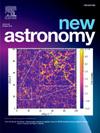基于人工神经网络插值和全光谱拟合的NGC 6397恒星物理参数
IF 2.1
4区 物理与天体物理
Q2 ASTRONOMY & ASTROPHYSICS
引用次数: 0
摘要
恒星光谱插值是拟合软件导出恒星物理参数的关键技术。这种方法是必要的,因为由于计算的复杂性和高成本,不可能即时生成合成恒星光谱。本研究的目的是利用人工神经网络(ann)为合成光谱库开发一个光谱插值器。本研究的目的是通过自反演来检验所训练的插值器的准确性,随后利用甚大望远镜(VLT)上的多单元光谱探测器(MUSE)获得的光谱,利用插值器推导出球状星团NGC 6397中恒星的物理参数。在这项研究中,人工神经网络被训练成光谱插值器。利用ULySS全光谱拟合包,结合训练好的插值器,提取了NGC 6397中1063颗恒星的1587个光谱的物理参数。经过训练的人工神经网络插值器实现了恒星参数的精确测定,Teff的平均差值为31 K, [Fe/H]的平均差值为0.01。该研究证明了基于人工神经网络的光谱插值在恒星参数确定中的有效性,提供了更快、更准确的分析。本文章由计算机程序翻译,如有差异,请以英文原文为准。
Physical parameters of stars in NGC 6397 using ANN-based interpolation and full spectrum fitting
Stellar spectral interpolation is critical technique employed by fitting software to derive the physical parameters of stars. This approach is necessary because on-the-go generation of synthetic stellar spectra is not possible due to the complex and high cost of computation. The goal of this study is to develop a spectral interpolator for a synthetic spectral library using artificial neural networks (ANNs). The study aims to test the accuracy of the trained interpolator through self-inversion and, subsequently, to utilize the interpolator to derive the physical parameters of stars in the globular cluster NGC 6397 using spectra obtained from the Multi Unit Spectroscopic Explorer (MUSE) on the Very Large Telescope (VLT). In this study, ANNs were trained to function as spectral interpolators. The ULySS full-spectrum fitting package, integrated with the trained interpolators, was then used to extract the physical parameters of 1587 spectra of 1063 stars in NGC 6397. The trained ANN interpolator achieved precise determination of stellar parameters with a mean difference of 31 K for and 0.01 dex for compared to previous studies. This study demonstrates the efficacy of ANN-based spectral interpolation in stellar parameter determination, offering faster and more accurate analysis.
求助全文
通过发布文献求助,成功后即可免费获取论文全文。
去求助
来源期刊

New Astronomy
地学天文-天文与天体物理
CiteScore
4.00
自引率
10.00%
发文量
109
审稿时长
13.6 weeks
期刊介绍:
New Astronomy publishes articles in all fields of astronomy and astrophysics, with a particular focus on computational astronomy: mathematical and astronomy techniques and methodology, simulations, modelling and numerical results and computational techniques in instrumentation.
New Astronomy includes full length research articles and review articles. The journal covers solar, stellar, galactic and extragalactic astronomy and astrophysics. It reports on original research in all wavelength bands, ranging from radio to gamma-ray.
 求助内容:
求助内容: 应助结果提醒方式:
应助结果提醒方式:


